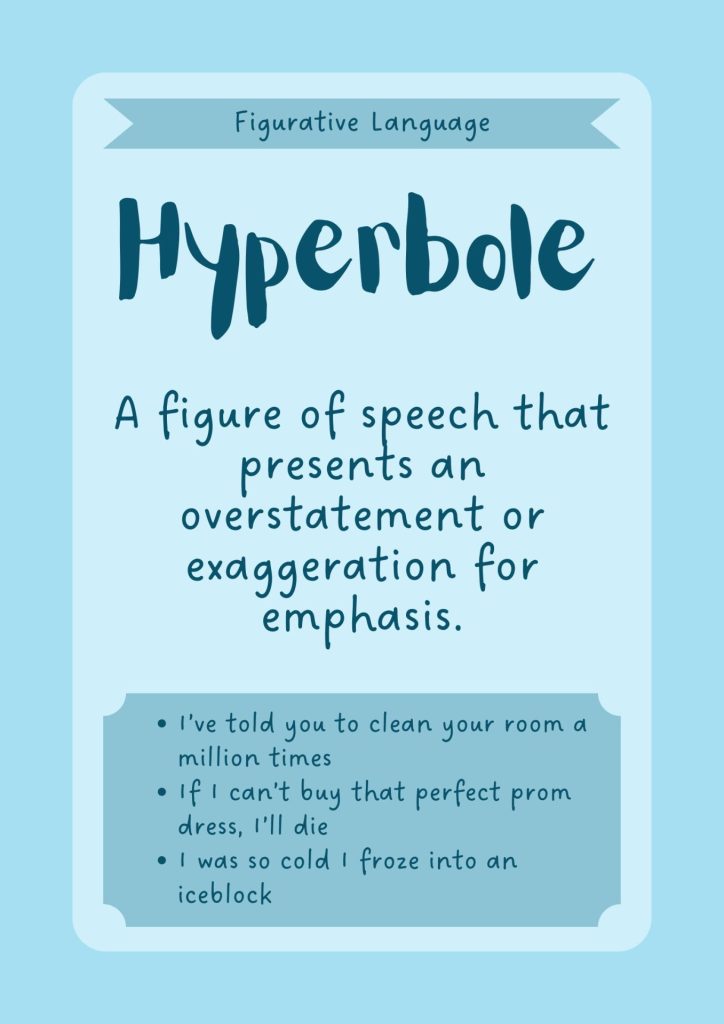Understanding Hyperbole: Definition and Examples
Table of Contents
Introduction
Hyperbole
In the realm of language and literature, the concept of hyperbole holds a significant place. Let’s delve into the world of hyperbole, exploring its definition, examples, and the impact it has on written expression.
Analogy of Definition
What is a Hyperbole?
Hyperbole, as a figure of speech, encompasses the use of extreme exaggeration to convey a point or evoke a particular response. It serves as a powerful tool in the arsenal of writers, adding depth and intensity to their work.

Method
Identifying Hyperbole
Recognizing hyperbole in writing involves identifying statements that are intentionally exaggerated for effect. It requires an understanding of the context and the author’s intent in using hyperbolic language.
Take, for instance, Mark Twain’s classic novel ‘The Adventures of Tom Sawyer,’ where Tom and his friends embark on grand adventures that are described with hyperbolic fervor. Twain’s larger-than-life depictions of childhood escapades amplify the excitement and whimsy of the narrative, drawing readers into a world where every tree is a towering fortress and every mud puddle a treacherous sea.
But hyperbole doesn’t stand alone; it often partners with personification to elevate the literary experience. In William Wordsworth’s poem ‘I Wandered Lonely as a Cloud,’ the speaker describes a field of daffodils with hyperbolic exaggeration, likening them to ‘a crowd, a host of golden daffodils.’ This hyperbolic portrayal, coupled with the personification of the daffodils dancing, transforms a simple scene into a vivid tapestry of nature’s beauty, leaving a lasting impression on the reader’s imagination.
How to Use Hyperbole?
Using hyperbole in your writing can inject energy, humor, and emphasis into your prose. Here are some ways to help you wield hyperbole with finesse:
- Identify the Purpose: Determine why you want to use hyperbole in your writing. Are you aiming to add humor, create drama, or emphasize a point? Understanding your intent will guide how you incorporate hyperbole into your piece.
- Know Your Audience: Consider your audience’s expectations and preferences. While hyperbole can be entertaining, overuse or inappropriate application may alienate certain readers. Tailor your use of hyperbole to resonate with your intended audience.
- Choose the Right Moments: Select moments in your writing where hyperbole can enhance the impact of your message. Whether it’s describing a character’s emotions, exaggerating the scale of an event, or amplifying the characteristics of an object, hyperbole works best when strategically employed.
- Exaggerate with Creativity: Let your imagination run wild! Hyperbole thrives on creative exaggeration. Don’t be afraid to push the boundaries of reality to create vivid and memorable imagery. However, ensure that the exaggeration remains within the realm of believability to maintain reader engagement.
- Balance with Reality: While hyperbole allows for exaggeration, grounding your writing in reality can prevent it from veering into absurdity. Pair hyperbolic statements with concrete details or realistic descriptions to maintain credibility and keep readers connected to your narrative.
- Revise for Effectiveness: After incorporating hyperbole into your writing, review and revise to ensure it serves its intended purpose. Trim any instances of hyperbole that feel forced or detract from the overall flow of your piece. Aim for a balance where hyperbole enhances rather than overwhelms your writing.
Examples
Example 1: ‘I’ve told you a million times to clean your room!’
Example 2: ‘This bag weighs a ton!’
Example 3: ‘I’m so tired, I could sleep for a year!’
These examples illustrate the use of hyperbole in everyday language, where extreme exaggeration is employed to emphasize a point or convey a strong emotion. By amplifying the situation beyond reality, hyperbole adds a touch of drama and intensity to the statements.
Quiz
Tips and Tricks
1. Emphasizing a Point
Tip: Use hyperbole to emphasize a particular characteristic or situation, making it stand out in the reader’s mind.
2. Eliciting Emotions
Tip: Employ hyperbole to evoke strong emotions in the reader, creating a memorable impact.
3. Adding Humor
Tip: Infuse hyperbole with humor to lighten the mood and engage the audience.
4. Creating Vivid Imager
Tip: Utilize hyperbole to paint a vivid picture in the reader’s mind, making the writing more compelling.
5. Making a Lasting Impression
Tip: Use hyperbole to leave a lasting impact on the audience, ensuring that the message resonates long after the reading.
Real life application
Real-Life Applications of Hyperbole
Scenario 1: The Tall Tale
In everyday conversations, individuals often use hyperbole to exaggerate a story or an event, adding an element of excitement and entertainment.
Scenario 2: The Sales Pitch
Marketers frequently employ hyperbole to create a sense of urgency and importance, emphasizing the benefits of a product or service in a memorable way.
Scenario 3: The Comedic Performance
Comedians use hyperbole to create humor, exaggerating situations to elicit laughter and engage the audience.
FAQ's
Like? Share it with your friends

